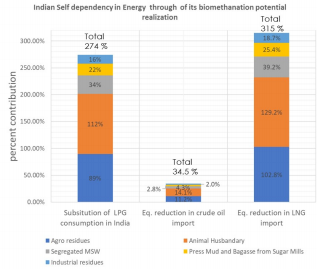
Dr. A.R. Shukla- President, IBA
It’s indeed heartening to learn of India is gearing up for the paradigm shift towards being self dependent through the Atmanirbhar Bharat Abhiyan. Within this context, Biogas/ Bio-CNG/ CBG/ RNG can potentially turn out to be the panacea that promises to hit many birds in one shot. With three distinct outputs of ‘Biogas/ Bio-CNG/ CBG/ RNG plants, these plants work as ‘Biomass waste treatment and pollution abatement Plants, ‘Organic Fertilizer Production plants’ and ‘Gaseous fuel (Biogas) Generation plants’, thereby helping in solving three burning problems of pollution, energy and need for eco-friendly organic fertilizer. Some of the crucial aspects that needs categoric intervention to facilitate leapfrogging of this sector are hereby portrayed.
It’s no brainer that ceteris paribus, gradual removal of bottlenecks towards insertion of bio methane in existing Natural Gas Grid shall significantly ramp the industry growth upon truly exploiting the bio-methane potential. Such a utopian scenario shall have tremendous positive financial, social and environmental impact, such as generation of massive employment
opportunities, reduction in fossil fuel and synthetic fertilizer import (Refer Table-I and Table II), meeting the requirement of ‘strategic fuel’ for managing emergency situations by producing local resource based indigenous ‘Make in India’ energy and organic fertilizer products, aiding decongestion along with scientific waste management in cities thus fructifying the objects of ‘Swachh Bharat Mission’, and facilitating the opportunity to re-build a sustainable and self reliant India (Atmanirbhar Bharat)’.
Table I
The salient outputs, mentioned above shall result from minimum 62.2 million metric tonnes of Bio-CNG generation along with the production of about 658.42 million tonnes of bio/organic fertilizer annually. Putting it quantitatively, this shall result in employment generation of about 1.33 million personnel (Refer Table III for break-up); scientific waste treatment through digestion of 1286.88 million tonnes of biomass waste annually thereby reducing annual GHG emissions of 265.88 million tonnes of CO2eqv., which is commensurate with 11.2% of the total GHG emission in India (based on 2015 level). Altogether, this will potentially save huge cost incurred in pollution abatement and healthcare.
Table II
Table III- Break-up of Employment opportunity upon realization of complete bio-methane
potential
| Function/ Role | Educational Skill and Qualification Level | Key skills | Personnel needed to harness complete bio- methane potential |
| Manufacturing | Highly skilled | Research and product development | 36,000 |
| Business Development | Highly skilled | Tracking the market, Drafting bids, Land selection, Project Finance | 15,000 |
| Design & Pre- Construction | Highly skilled | Plant design engineering | 24,000 |
| Construction & Commissioning | Highly skilled ___________________ Semi and Low Skilled | Site engineering _______________________ Electricals training and plant installing | 48,000 ________________ 1,50,000 |
| Operation & Maintenance | Highly skilled ___________________ Semi and Low Skilled | Performance data monitoring _________________________________ Fitter, Electricians, Labour | 30,000 __________________ 1,50,000 |
| Indirect Employment across the value | Low Skilled/semi- skilled | Waste collection (primary and secondary), Farming, sales | 3,39,750 |
| Chain | channel for org. fertilizer sales, sales channel for other by-products | ||
| Supporting infrastructure- gas grid (micro/mini), bio-CNG dispensing outlets | High skilled/ Semi Skilled ____________________ Low Skilled/semi- skilled | Administration, Site Engineering _________________________________ Fitter, Electricians, Labour, Operators | 2,16,000 _____________________ 3,24,000 |
| Total | 13,32,750 |
However, it’s worthwhile to bring to put forth that there are several Ministries encompassing MNRE, MoPNG, MoDWS, MoCF, MoHUA, MoAFW, MoEFCC, and few others, which are handling/ supporting this sector, including at least one of the three main deliverables of biogas generation or organic fertilizer production or biomass waste treatment. This has always led to inadequacy of required support to the sector. As a result, these Ministries individually/collectively could not harness the realistic potential of Biogas/ Bio-CNG)/ CBG/ RNG sector. The need of the hour is to pool and integrate all the inter-Ministerial incentives, relevant to Bio-CNG industry, through better coordination amongst all the Ministries with MNRE being the focal Ministry of all.
In fact, there is a need to implement a paradigm shift in formulating pragmatic policies in terms of moving towards, ‘Generation based Incentive (GBI)’ from the existing upfront subsidy regime (refer Table IV for estimation related to GBI) and provisioning for Credit Guarantee scheme for facilitating swift lending process from Financial Institutions (Banks, NBFC, etc.). Same could be achieved upon setting-up a ‘Biogas-Fertilizer Fund’. For harnessing the total generation potential of 62.2 million tonnes p.a. of Biogas/ Bio-CNG/ CBG/ RNG in India, the proposed “Biogas-Fertilizer Fund” will have an estimated corpus requirement of Rs. 9,44,664 crores (Refer Table V), of which Rs. 97,392 crores will be pegged towards the ‘Credit Guarantee scheme’ and remaining Rs. 8,47,272 crores towards ‘Generation based Incentive (GBI)’ @ Rs.20/- per kg of Bio-CNG (produced as per BIS Standards) for 15 years of tentative plant life. With this outlay of Rs. 9,44,664 crores for the sector, there will be an enormous overall return to the govt. in the form of savings from reduction in crude oil import, nutrient-based subsidy savings on chemical fertilizers, and meeting the GHG emission reduction target (@ price of Certified Emission Rating CER) as per the Nationally Determined Contributions-NDCs (Refer Table VI). The consolidated savings on above accounts are estimated at approximately Rs. 11,02,200 crores in 15 years span (useful life of a typical biogas/ Bio-CNG plant). Thus, the net value creation turns out to be Rs.1,57,536 crore, which is a net surplus for the Govt. Exchequer through harnessing of total Bio CNG/ CBG/ RNG potential in India. Also, it’s worthwhile to note that under the launched SATAT scheme, over the next five years, its envisaged to set-up about 5000 plants, which would facilitate harnessing around one-sixth of the aforementioned total potential of 62.2 million tonnes of bio-CNG per annum.
Table IV- Determination of Bio-CNG Price for a Typical 5 TPD Bio-CNG/ CBG/ RNG Generation
plant
| S. NO | Estimated Expenditure per kg of Bio-CNG | Amount (Rs.) (3) | Item of Revenue Sources per kg of Bio-CNG | Amount (Rs.) (4) | Generation Based Incentive (GBI) Requirement (difference of Column 3 and 4) |
| 1. | Levelized Cost of the Plant | 55.62 | Contribution from Manure Sales | 7.70 | |
| 2. | Variable Cost of operating the Plant | 18.11 | Bio-CNG sales (SATAT off take price) | 46.00 | |
| Total: | 73.73 | 53.70 | 20.03 |
Note:
- Above estimated table is subjected to change based on different scenarios and assumption of various parameters
such as feedstock price, CAPEX, OPEX, WACC, cost and price escalation, and so on. - Levelized Cost includes-CAPEX/Depreciation, Finance Cost, Operation and Maintenance, Plant Overheads
- Variable Cost includes- Feedstock and its Transportation Cost
- Above estimated table is subjected to change based on different scenarios and assumption of various parameters
such as feedstock price, CAPEX, OPEX, WACC, cost and price escalation, and so on. - Levelized Cost includes-CAPEX/Depreciation, Finance Cost, Operation and Maintenance, Plant Overheads
- Variable Cost includes- Feedstock and its Transportation Cost
Table V-Total Funds Requirement in terms of ‘Credit Guarantee Scheme’ and GBI
Corpus’ for harnessing Bio-CNG/ CBG/ RNG Potential in India
| S. NO | Particulars of harnessing of Bio-CNG/ CBG/ RNG | Credit Guarantee Requirement (in Rs. Crore) | GBI Corpus Requirement* (in Rs. Crore) | Total Funds Requirement (in Rs. Crore) |
| 1. | Harnessing target under SATAT | 14,875 | 1,24,298 | 1,39,173 |
| 2. | Harnessing Total Potential | 97,392 | 8,47,272 | 9,44,664 |
Table VI- Estimated Monetary Savings through Harnessing Total Biogas/ Bio-CNG/ CBG/ RNG
Potential in India
| S. No. | Particulars | Estimation Basis | Estimated Annual Savings to Govt. Exchequer by Harnessing Total Bio- CNG Potential in India ( in Rs. Crore) | *Estimated 15 years Plant-life-Savings to Govt. Exchequer by Harnessing Total Bio- CNG Potential in India (in Rs. Crore) |
| 1. | Equivalent Foreign Exchange Outflow on Crude oil import | US Dollar per Barrel | 1573.62 | 10,71,800 |
| 2. | Subsidy on Chemical Fertilizers | NBS per Kg of N,P,K | 35.38 | 24,100 |
| 3. | GHG Emissions Reduction Savings | Prevailing CER price | 9.31 | 6,300 |
| Total: | 1618.30 | 11,02,200 |
Note: * Values are reported as discounted PV @ 12 % p.a.
NBS- Nutrient Based Subsidy, CER- Certified Emission Ratings
So, in view of the ‘Atmanirbhar and Swachh Bharat’, there is a need to steer and drive a pragmatic policy-supported-ecosystem that shall enable harnessing the afore-mentioned potential of Bio-CNG and its other supplementary offerings, by including minimum of the following:
a) Harmonization and Integration of all the present schemes and required clearances and
permissions relevant to the biogas/ Bio-CNG industry under different Ministries
b) Supporting creation of ‘Mini-biogas, Bio-CNG Grids’ and its onward integration with ‘Natural
Gas Grid’ along with ‘ Organic Fertilizer distribution and utilization Infrastructure’.
c) Transgression from the existing upfront subsidy model to GBI model.
d) Creating the ‘Biogas-Fertilizer Fund’ with an estimated corpus requirement of Rs. 9,44,664
crores as provision towards Credit Guarantee schemes and corpus for ‘Generation Based
Incentive and building Bio-CNG infrastructure’. To begin with, an initial provision of
Rs.1,39,173 crore for five years can be earmarked.
e) Setting-up of ‘Biomass Resource Bank (BMRB)’ for assured biomass/waste supplies to the
installed plants.
f) There is a need to bring ‘Bio-CNG sector in the category of Social Infrastructure, as waste
treatment is not internalized and with non-paying capacity of farmers to buy organic fertilizer
of these plants.

























 LOGIN
LOGIN
 DAFTAR
DAFTAR
 WA
WA
 LIVECHAT
LIVECHAT